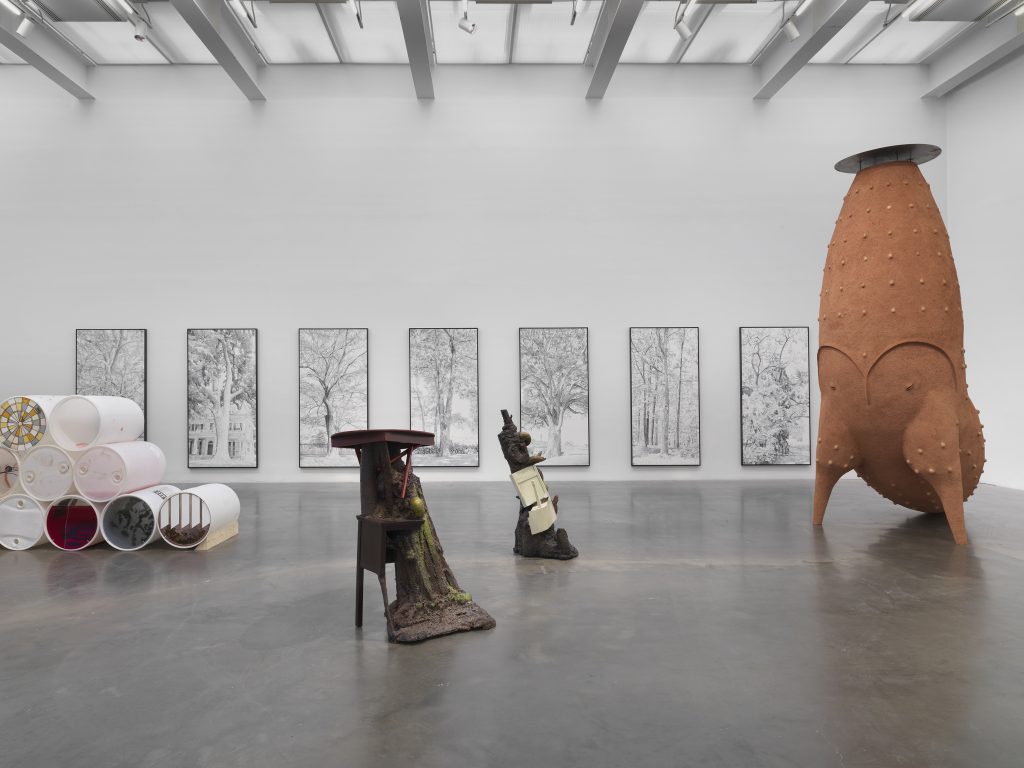
The New Museum Triennial is, as ever, an international show. About one third of the artists in its 2021 edition hail from North America, and the rest from points elsewhere, so it can’t really reflect a national mood in a simple way. Yet it does reflect what its U.S.-based curators, Margot Norton and Jamillah James, think their audience might need or want. And there’s even a reading of “Soft Water Hard Stone,” which opened last month, as a “Biden Biennial.”
Back in 2018, the last edition of this show was called “Songs for Sabotage.” One of the big keywords its curators used to define the show’s purpose was “propaganda.” In the thick of the Trump presidency, that show’s curators sought to convey in their statements a sense of urgency for its core U.S. audience.
Compare this rhetoric to “Soft Water Hard Stone” and the latter comes to feel very much like a post-Trump show (even if the curators selected most of the 40 artists during the Trump presidency.) The will to perform immediacy is diffused; the show’s title, from a Brazilian proverb about how a gentle force will eventually wear down even the hardest obstacle, celebrates incremental action. Everything feels very hushed and withdrawn, as if in the wake of something.
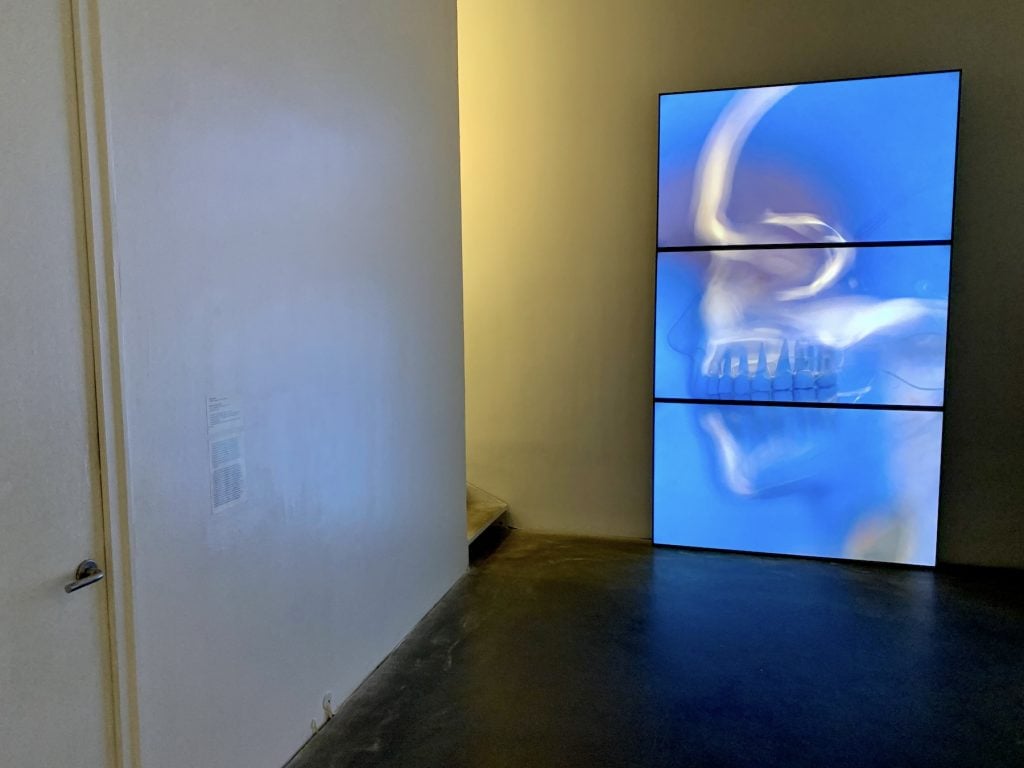
This show continues the feeling at other recent big international survey shows of seeking grounding in folklore and crafts, adding to these an even greater sense of retreat from anything too in-your-face or definite, maybe in reaction to an over-crowded, hyper-mediated culture.
A retreat from mediation is reflected, I think, in the utter vanishing of photography, conceptual or otherwise, as a medium. There’s not much to suggest popular culture, besides a clip of rapper Nicki Minaj, interlaced with quotes from Marx, in a video playing within Gaëlle Choisne’s collage environment, Temple of Love—Love to Love (2021).

There’s also hardly a thing that signals the digital, save for Kate Cooper’s looping video that seems to show fragments of digitally rendered anatomy, cross sections of veins and bones coming in and out of focus, and Sandra Mujinga’s Pervasive Light, featuring a spooky, driving electronic soundtrack and a cloaked figure, her image shimmering with electric orange accents as it moves into and out of darkness—a reflection on “how Black bodies can harness invisibility.” Both videos are purgatorial.
There is also scant painting—and the painting there is always constructed to leave you with some feeling that the image is holding something back, whether its Canadian Ambera Wellman’s willfully unresolved panoramic canvas of turbid, obscured odalisques, or U.S. painter Cynthia Daignault’s black-and-white paintings of landscapes that turn out, when you read the label, to be where lynchings took place.
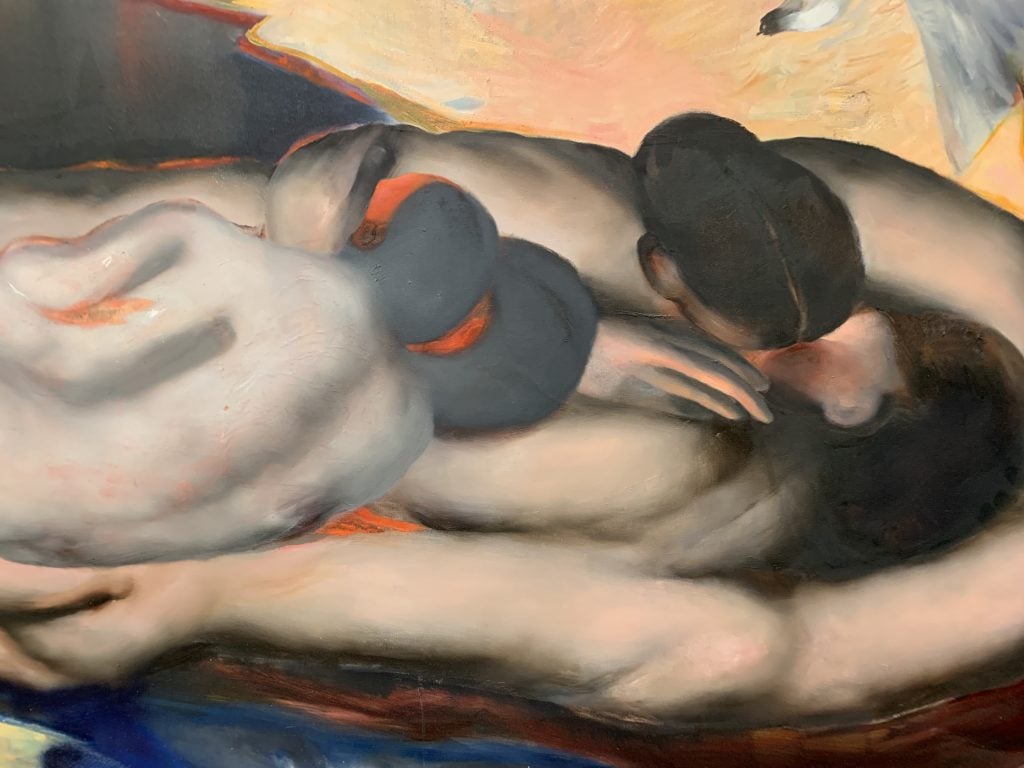
On the other hand, there are multiple things with rotting or biological matter, as if to evoke real physical nature, and multiple things that evoke broken machines, as if flagging a sense of the post-industrial wreckage left behind by the frenetic entertainments of the digital economy.
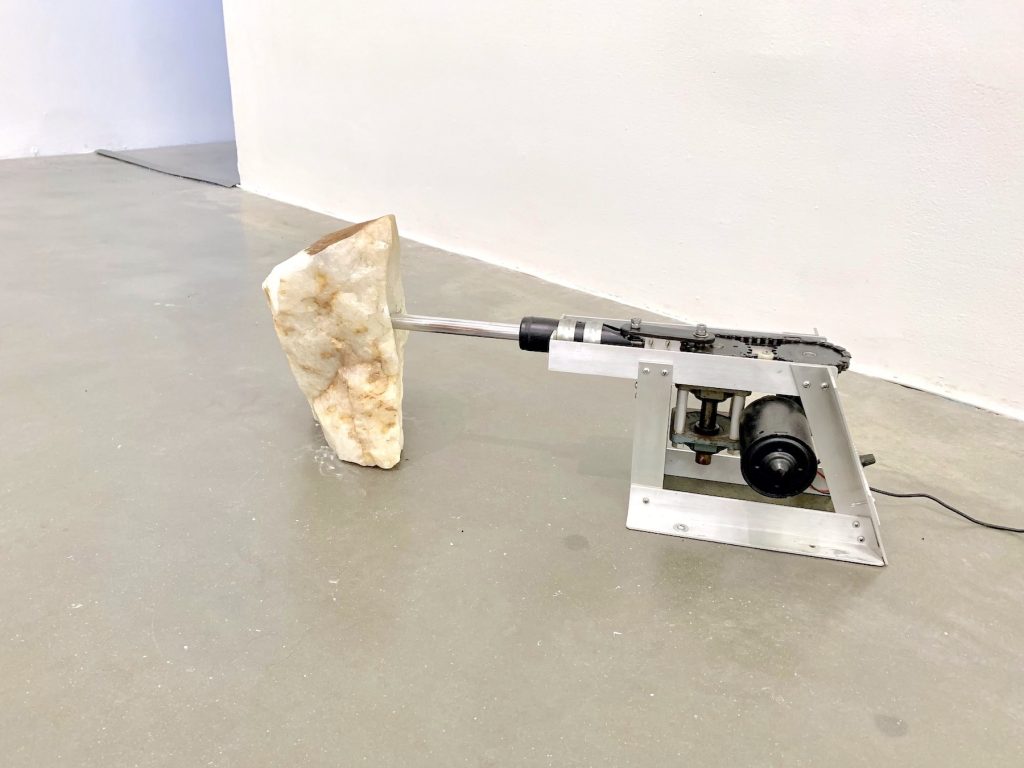
These include actual functional art-machines in the very good work of Brazilian sculptor Gabriela Mureb, the best of which gives the show its name: a small contraption, placed on the floor, tapping slowly and relentlessly against a piece of stone, filling the fourth-floor galleries with a lulling rhythm.
The ground-floor windows of the New Museum facing the Bowery are adorned and obscured with artwork by British artist Samara Scott, Gargoyle (Lonely Planet): webbing, centerless tendrils of gooey junk. And, just as this public-facing work advertises, there are many things within that either look as if they are made of junk or are actually made of junk—decorous bits of ruin transplanted to the wall or to a pedestal.
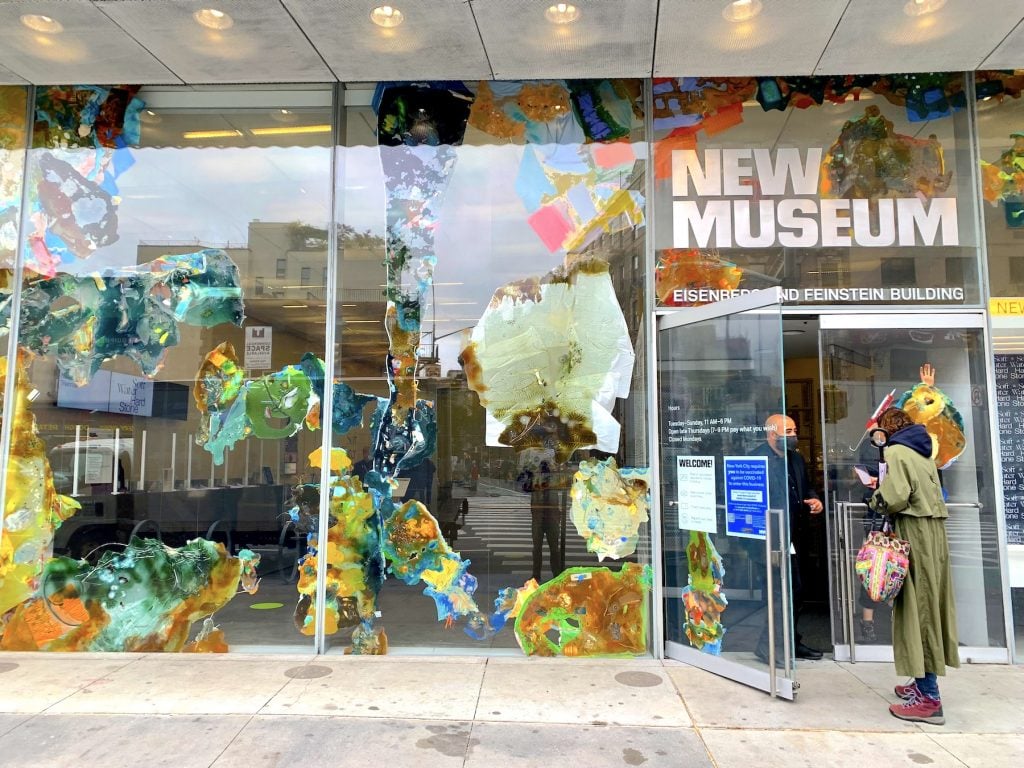
There is a sense, everywhere, of savoring the minor, of small and precious things burdened with an epiphany that may or may not arrive. So you will find the work of British artist Ima-Abasi Okon, who has inserted bronze ventilation grates into the wall at calf height and then stuck some jewelry in it.
![Ima-Abasi Okon, Put Something in the Air: The E-s-s-e-n-t-i-a-l Mahalia Jackson Blowing Up DJ Pollie Pop’s Chopped and Screwed Rendition of Wagner’s Ride of the Valkyries — Military-Entertainment Complex Dub [Jericho Speak Life!]*(Free of Legacy)* (2017). Photo by Ben Davis.](https://news.artnet.com/app/news-upload/2021/10/ima-abasi-okon-1024x768.jpeg)
Ima-Abasi Okon, (2017). Photo by Ben Davis.
Jewelry recurs as a motif in U.S. artist Rose Salane’s display of rings, found on the beach in Atlantic City. Each is an unimpressive, chintzy thing, displayed next to a label listing the readings it gave on a metal detector and transcribing a report on its history from an “intuitive reader” (a.k.a. a psychic). It’s a charming gesture, but what’s striking is how little of interest the readings turn up. The reader doesn’t find big murder stories or outrageous romance; just fabulated half-glimpses of normal lives.
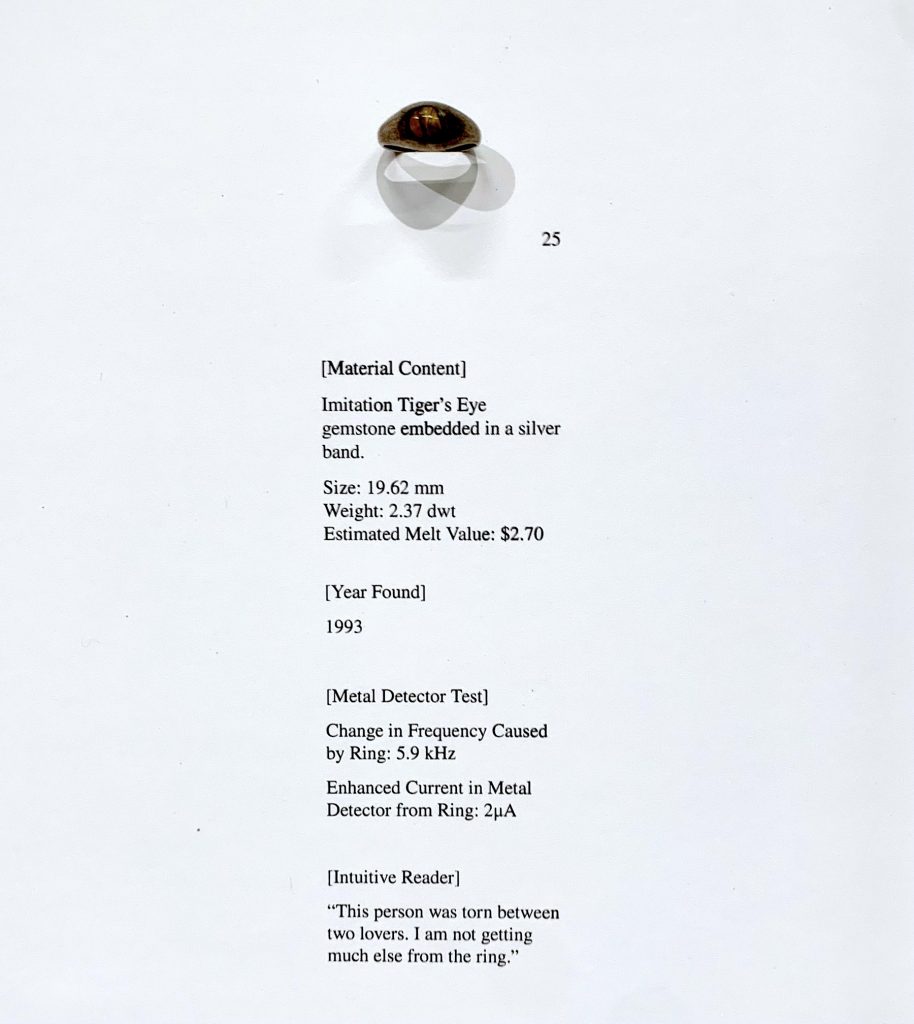
Brazilian artist Ciara Ianni’s “Labor Drawings,” 14 minimal works on graph paper, each represent via a lucid graphite line the route to work of one of the workers at the New Museum. It’s probably the most forceful work in the show—and it’s not that forceful. The gesture of comparing the situations of different workers is significant in light of the wave of labor struggles that have washed over the museum world, and the New Museum specifically. In spirit, however, it is much more wry than outspoken.
There are six moving-image works in the show, totaling about one hour 50 minutes if you sit through them all. Most have the lyrical didacticism that is the current international art style, video essays that move digressively through a topic. Danish filmmaker Amalie Smith’s 3D film speculating about the origins of life is the loveliest of these, meandering through science and archeology.
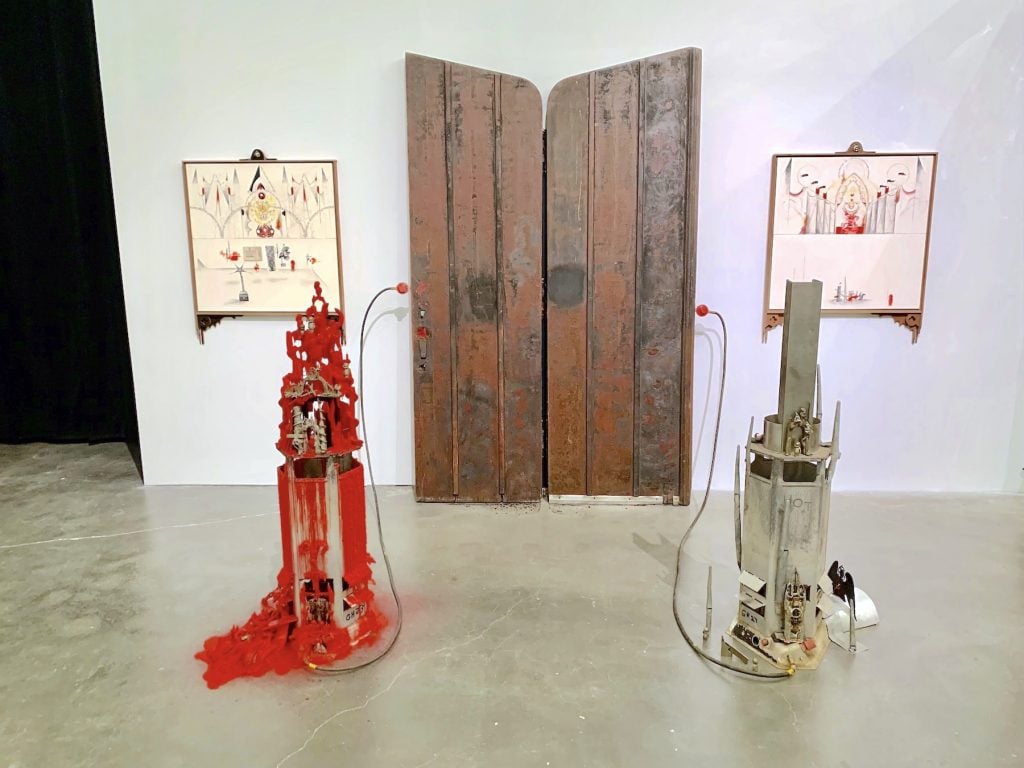
I like a lot of things here. I like Harry Gould Harvey IV’s anarchist altar a lot. I like Evgeny Antufiev’s wallpaper and mock museum display of homespun gold masks and chalices. Christina Pataialii’s earth-toned, indecipherable semi-abstract paintings have grown on me over time, as have ceramicist Erin Jane Nelson’s odd, exploded pottery shard reliefs.
Thinking about the whole thing, my feelings are very muted. Though that’s not the best recommendation, this sensibility also feels purposive. It’s possible that it reflects a moment of intellectual and emotional exhaustion in the culture, a suspicion about big hopes and a despair at honest communication. It also occurs to me that though a lot of its artistic strategies feel like a reaction to a fatiguingly and increasingly dystopian attention economy, I also am left wondering whether it redoubles, within museum art’s own high-brow material idiom, the retreat into personally curated cultural worlds that is one of the legacies of the last year of isolation.
The stand-out moment of the show comes right on the ground floor, in the New Museum’s lobby galleries which always somehow feel like both prologue and afterthought. For this triennial, this space offers a pair of installations, one by Peruvian artist Arturo Kameya and the other by the duo Amy Lien and Enzo Camacho, from the U.S. and the Philippines.
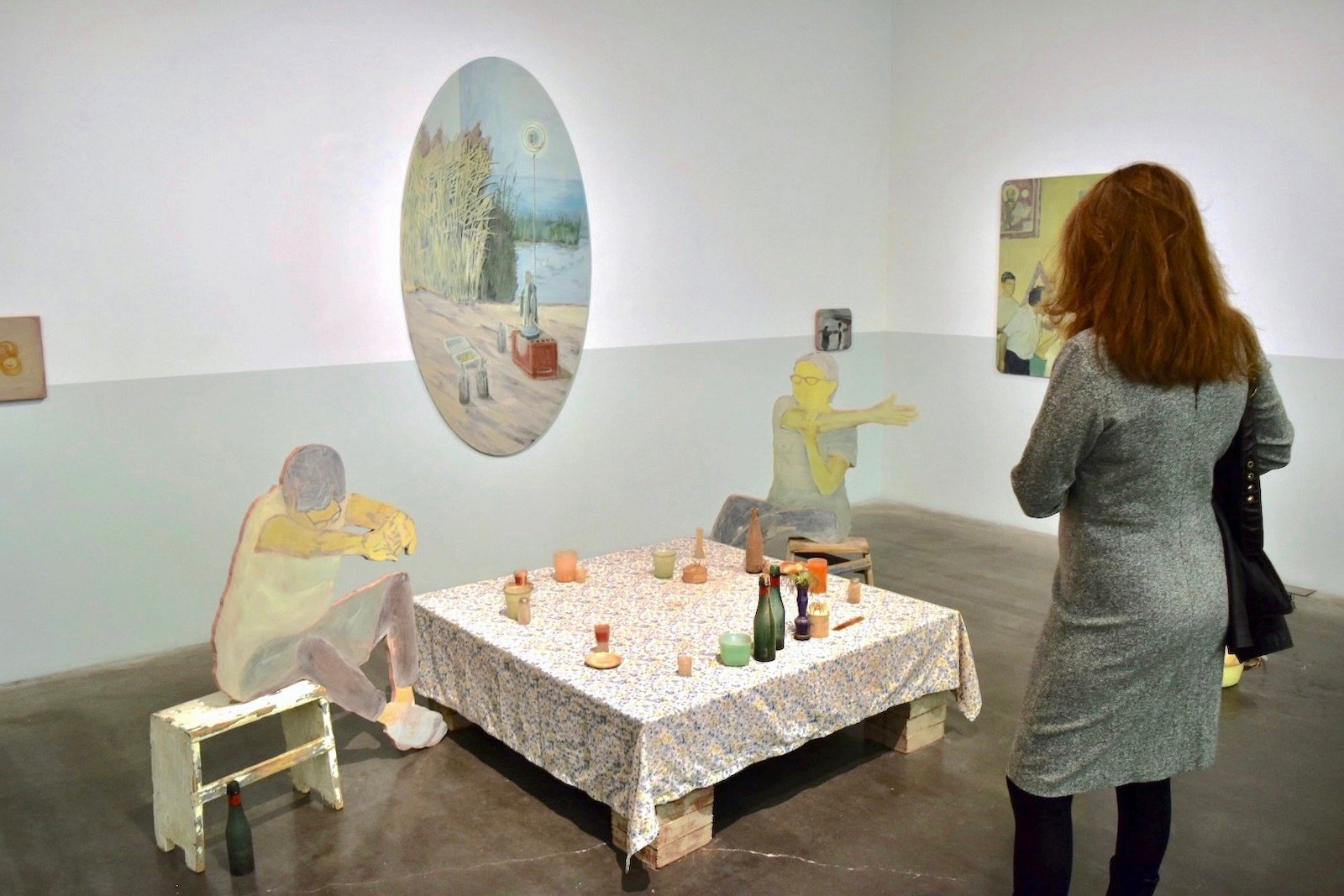
The first work, Kameya’s, is a room full of washed-out paintings and cut-outs and props: a low-slung table, a small fenced-off garden. Who can afford to feed more ghosts (2021), as it is called, is meant as a “dinner for ghosts” and has a complex subtending narrative about recent Peruvian political history that is hard to decode without some research. Its faded colors make it feel as if you have happened upon an abandoned theater set.
And then, at moments, it comes to life. A mechanical fish on a plate periodically jerks around. Cups on the table suddenly shift as if haunted. These offbeat animated touches made me laugh out loud. The jolt of startled amusement was disproportionate, as if these comic moments gave vent to a secret current of emotional energy running underneath this whole show.
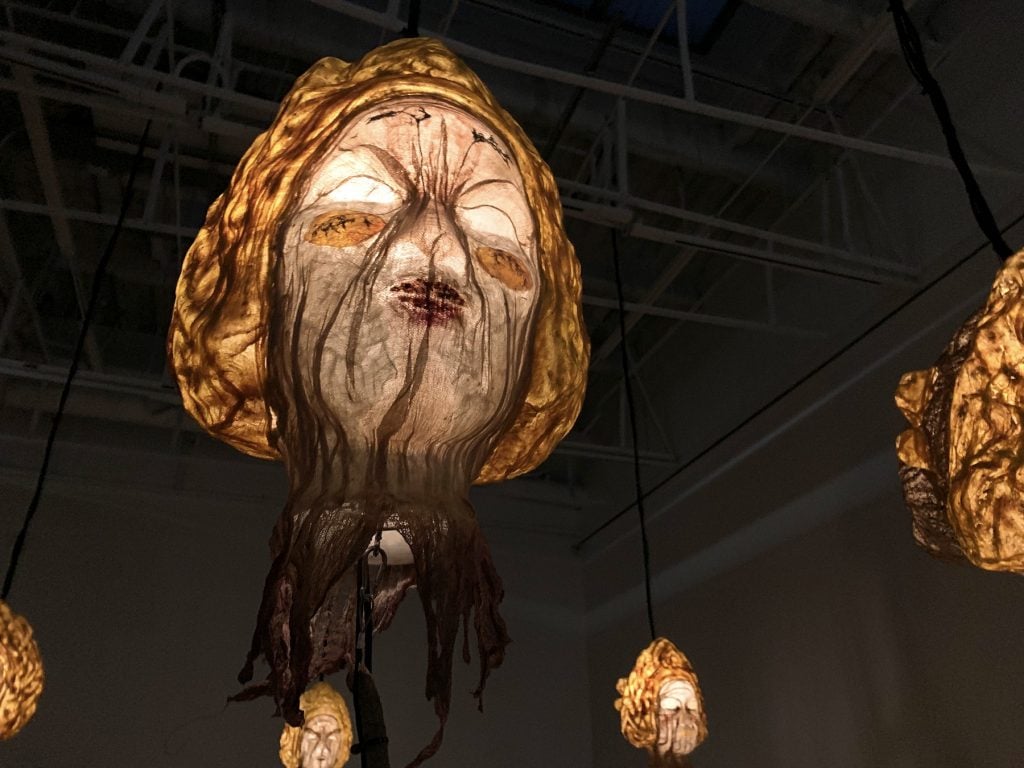
Then, in the next chamber you arrive at Waves move bile (2020), a swarm of lambent rice-paper heads, floating on sticks, slowly pulsing with light in an otherwise darkened space. Again, there is a complex set of references being woven together—the faces drawing on an image of a racist French monument using a nude Southeast Asian woman as an allegory for the “Colonies of Asia,” but repurposing her facial features so that they assume the form of a mythical spirit from the folklore of the Philippines and Cambodia.
More than anything else, this is just an effectively memorable piece of sculpture, fully fitting within the tender idiom of this show. But what I realized, after a second, is that these faces stand out to me here because I feel as if they are facing me.
They made me realize that the show overall has left me feeling uncertain about where to stand, about whether there is any right orientation on its works. A sense of being lost and looking for meaning permeates the whole of “Soft Water Hard Stone”—which definitely captures a mood.
“Soft Water Hard Stone” is on view at the New Museum, New York, through January 1, 2022.
Follow Artnet News on Facebook:
source: https://news.artnet.com/opinion/soft-water-hard-stone-triennial-2031118
Your content is great. However, if any of the content contained herein violates any rights of yours, including those of copyright, please contact us immediately by e-mail at media[@]kissrpr.com.
